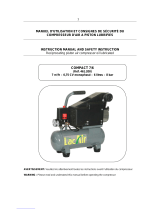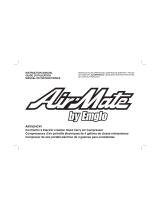
— 16 —
Français
13. ENTRETENIR LE COMPRESSEUR AVEC SOIN.
Suivre les instructions de lubrification.
Inspecter régulièrement les cordons et, s’ils sont
endommagés, les faire réparer dans un centre de
service après-vente agréé. Inspecter périodiquement
les cordons de rallonge et les faire réparer s’ils sont
endommagés.
14. CORDONS DE RALLONGE POUR UTILISATION À
L’EXTÉRIEUR.
Si l’outil doit être utilisé dehors, utiliser exclusivement
des cordons de rallonge conçus pour l’extérieur et
identifiés comme tels.
15. RESTER SUR SES GARDES.
Bien faire attention à ce que l’on fait. Faire preuve de
bon sens Ne pas utiliser le compresseur lorsque l’on
est fatigué. Ne jamais utiliser le compresseur si l’on
est sous l’effet d’alcool, de drogues ou de
médicaments causant de la somnolence.
16. CONTRÔLER LES PIÉCES ENDOMMAGÉES ET
LES FUITES D’AIR.
Avant de continuer à utiliser le compresseur, vérifier
attentivement les protections ou autres pièces
endommagées pour déterminer si elles fonctionneront
correctement et rempliront la fonction prévue. Vérifier
si les des pièce mobiles sont bien alignées, s'il y a des
pièces mobiles voilées, des pièces cassées, si le
montage est correct, s'il y a des fuites d'air et toutes
autres conditions susceptibles d'affecter le bon
fonctionnement de l'outil.
Une protection ou toute autre pièce endommagées
devront être réparées correctement ou remplacées par
un service après-vente agréé, sauf spécification
contraire dans ce mode d'emploi.
Faire remplacer les contacteurs de pression
défectueux par un service après-vente agréé.
Ne pas utiliser le compresseur si l'interrupteur ne
permet pas de mettre le compresseur sous tension et
hors tension.
17. UTILISER LE COMPRESSEUR EXCLUSIVEMENT
POUR LES APPLICATIONS SPÉCIFIÉES DANS LE
MANUEL D’UTILISATION.
Ne jamais utiliser le compresseur pour des utilisations
autres que celles spécifiées dans le manuel.
18. MANIPULER LE COMPRESSEUR
CORRECTEMENT.
Faire fonctionner le compresseur conformément aux
instructions de ce manuel. Ne jamais laisser les
enfants, les personnes non familiarisées avec son
fonctionnement ou toute personne non autorisée
utiliser le compresseur.
19. VÉRIFIER QUE CHAQUE VIS, BOULON ET
COUVERCLE EST SOLIDEMENT VISSÉ.
Veiller à ce que chaque vis, boulon et plaque soit
solidement vissé. Vérifier périodiquement le serrage.
20. MAINTENIR L’ÉVENT D’AÉRATION DU MOTEUR
PROPRE.
L’évent d’aération du moteur doit rester propre en
permanence de façon à ce que l’air puisse circuler
librement. Contrôler fréquemment l’accumulation de
poussière.
21. FAIRE FONCTIONNER LE COMPRESSEUR À LA
TENSION NOMINALE.
Faire fonctionner le compresseur à la tension spécifiée
sur la plaque signalétique.
Si le compresseur est utilisé à une tension supérieure
à la tension nominale, il en résultera une vitesse de
rotation du moteur anormalement élevée risquant
d’endommager le compresseur et de griller le moteur.
22. NE JAMAIS UTILISEER UN COMPRESSEUR
DÉFECTUEUX OU DONT LE FONCTIONNEMENT
EST ANORMAL.
Si le compresseur paraît fonctionner de façon
inhabituelle, s’il produit des bruits étranges ou des
vibrations, ou s’il paraît malfonctionner pour une
autre raison, arrêter immédiatement de l’utiliser et
l’envoyer à réparer à un centre de service autorisé
Hitachi.
23. NE PAS NETTOYER LES PIÈCES DE PLASTIQUE
AVEC DU SOLVANT.
Les solvants tels qu’essence, diluant, benzine,
tétrachlorure de carbone et alcool risquent
d’endommager et de fendre les pièces de plastique.
Ne pas les nettoyer avec ce genre de produit.
Pour nettoyer le pièces de plastique, utiliser un linge
doux humecté d’eau savonneuse puis sécher
complètement.
24. UTILISER EXCLUSIVEMENT DES PIÈCES DE
RECHANGE HITACHI D’ORIGINE.
L’utilisation de pièces de rechange autres que celles
fabriquées par Hitachi peut entraîner l’annulation de la
garantie et être la cause d’un mauvais fonctionnement
et des blessures en résultant. Les pièces d’origine
Hitachi sont disponible auprès de son distributeur.
25. NE PAS MODIFIER LE COMPRESSEUR.
Ne pas modifier le compresseur. Toujours consulter
un centre de service après-vente Hitachi agréé pour
toute réparation. Une modification non autorisée
risque non seulement d’affecter les performances du
compresseur, mais également d’être la cause
d’accidents et de blessures pour le personnel de
réparation qui ne posséderait pas les compétences
techniques nécessaires.
26. DÉSACTIVER L’INTERRUPTEUR BAROMÈTRIQUE
LORSQU’ON NE SE SERT PAS DU COMPRESSEUR.
Quand le compresseur ne fonctionne pas, régler le
sélecteur de l’interrupteur barométrique sur «OFF»,
débrancher le compresseur et ouvrir le robinet de
vidange pour vider le réservoir d’air comprimé.
SÉCURITÉ (suite)
f_ec129_e.p65 4/8/04, 5:38 PM16






















